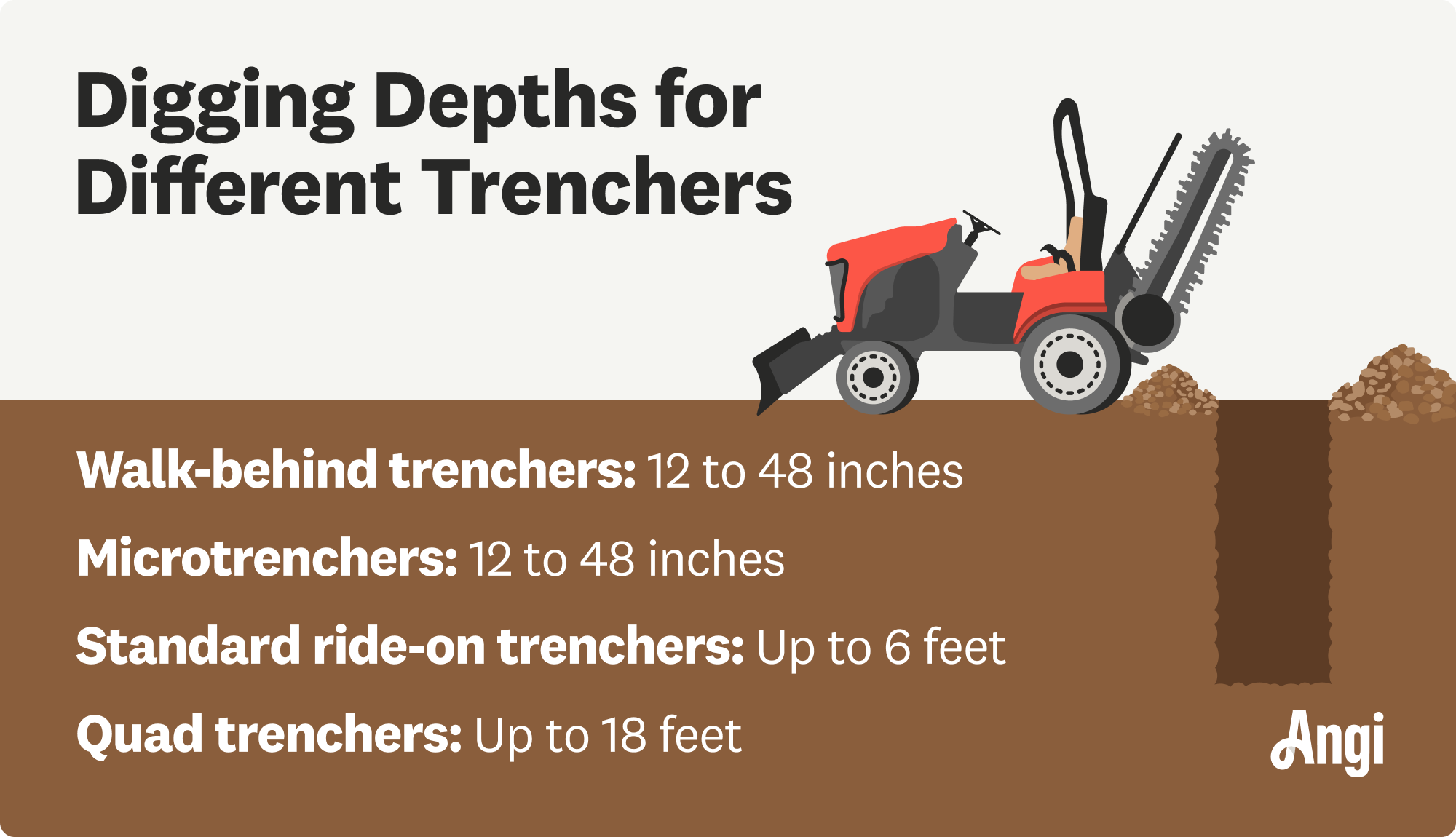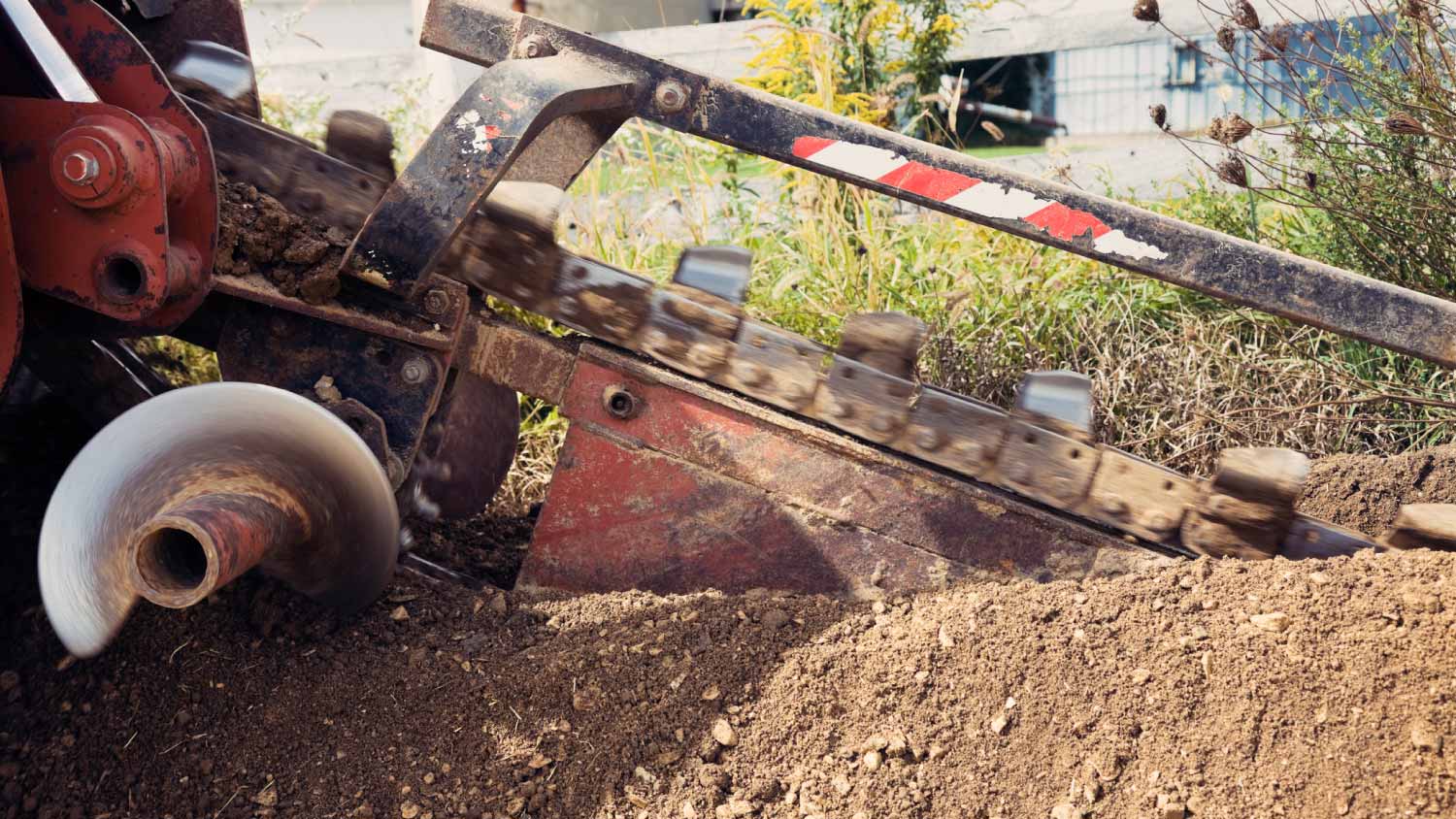
How much does it cost to demolish a house? Average prices for demolition vary based on home size, materials, and location. A partial demolition can make a project more affordable than a full house demolition. Keep reading for more.
Gotta get diggy wit’ it


Walk-behind trenchers dig up to 4 feet deep and 8 inches wide.
Small ride-on trenchers can dig up to 6 feet deep and 16 inches wide.
Choose a trencher type based on your needed depth, soil type, and terrain.
Always check local installation guidelines and call 811 before digging.
If you want to add plumbing to your pole barn or electrical to a shed, you’ll need to dig a trench to run the utility lines underground. Most residential-use trenchers can dig 12 inches to 6 feet deep, depending on the type of trencher. Larger models can reach up to 18 feet deep. Check out more important info about how deep a trencher will dig and what type of trencher to use for your project.
A non-commercial-use trencher will dig between 1 foot and 6 feet deep, depending on the type of trencher. Larger models for more complex jobs can reach up to 18 feet deep.
Here are the most common types of trenchers:
Walk-behind trenchers: 12 to 48 inches deep and 8 inches wide
Microtrenchers: 12 to 48 inches deep and 5 inches wide
Standard ride-on trenchers: Up to 6 feet deep and 16 inches wide
Quad trenchers: Up to 18 feet deep and 48 inches wide
When you look for trenchers, review the specs to ensure the machine can dig the depth and width you need for your project, local guidelines, and utility type. If you need some extra help planning, call an excavation pro near you for a little guidance.

There are several types of trenchers to rent or buy, each designed for different projects, depths, and terrain.
Walk-behind trenchers are ideal for short-term, small trenching projects, such as digging a trench less than 4 feet deep and 8 inches wide. Walk-behinds work well on properties with space constraints, and they don’t cause as much damage to the terrain as other types. They are more labor-intensive than ride-ons, but they’re far less labor-intensive than digging with a shovel.
Walk-behinds are less expensive to buy or rent because they don’t offer the same power and depth as ride-on models.
Microtrenchers are ride-on trenchers that dig deep, narrow trenches, cutting through everything from dirt to asphalt and pavement. Within a slender cut, less than three inches wide, micro trenchers cause minimal damage to the surrounding environment. Microtrenchers are ideal for installing cables in shallow trenches that are 4 feet deep or less.
Ride-on trenchers are drivable diggers, making them faster and less labor-intensive than walk-behinds and shovels. These trenchers can handle dense and rocky soil with ease. Rise-ons are great for projects longer than 250 feet, trenches wider than 8 inches, and trenches up to 6 feet deep. If you have a long trench to dig or multiple trenches, it makes sense to rent a ride-on trencher, but you’ll need to learn how to operate the machinery safely and accurately.
Quad trenchers are heavy-duty, powerful ride-on trenchers that are great for digging deeper than a standard ride-on. Quads can dig up to 18 feet deep and 48 inches wide. They also have different attachments to move material, place pipes, or backfill soil.

To ensure a smooth and effective dig, make sure you’re familiar with your property’s soil conditions and terrain and that you have a clear plan of action for your project. Here are the main factors to consider when choosing a trencher type:
Depth and width of the trench needed
Type of soil
Type of terrain (i.e., hilly, rocky, full of roots)
Obstructions and space restrictions
Surrounding environment and ecosystem
Familiarity and comfort level operating machinery
Time allocated to complete the project
Budget
Before trenching, check your local guidelines to see if a permit is required and if there are any special regulations for the utilities you’re installing. You should also call the 811 dig line. They’ll mark all underground utilities so that you can avoid personal injury, a gas leak, or damage to an existing utility line.
Before just setting it to “dig” and wishing yourself luck, learn how to use a trencher to ensure safe operation. If you don’t know what you’re doing, you could damage your property or hurt yourself or others. There’s also a very real risk of death if you’re not 100% sure how to safely operate a trencher. If you’re not confident about the job, contact local excavation companies to receive quotes and discuss your project.
From average costs to expert advice, get all the answers you need to get your job done.

How much does it cost to demolish a house? Average prices for demolition vary based on home size, materials, and location. A partial demolition can make a project more affordable than a full house demolition. Keep reading for more.

If you’re building a new home, you might need to consider the cost of digging out a basement. Use this pricing guide to get an estimate for the project.

Preparing for a big excavation project in your yard? Find out excavator rental prices by type, project size, and more to budget for your project.

Using a trencher is more efficient than using a shovel when excavating. Here’s a basic guide on how to use a trencher for your next project.

Can you add a basement to a house? Use this guide to learn the benefits and drawbacks of adding a basement to your home.

Discover what excavation is, the different types, and when it's needed in construction. Learn key insights for your next big home project.